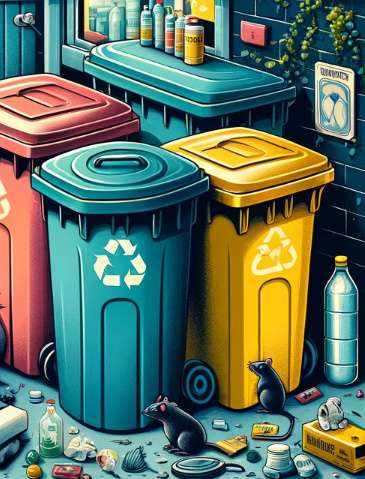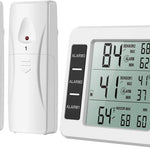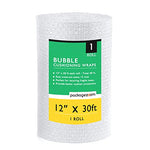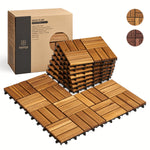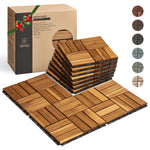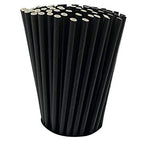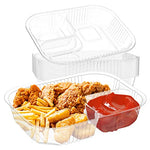You have no items in your shopping cart.
Have you ever noticed an unpleasant smell coming from your trash can or recycling bin? Proper storage of these materials is essential for maintaining a clean and healthy living or working environment. Not only can storing trash and recyclables prevent foul odors, but it can also prevent the accumulation of pests and potential hazards. Proper storage can also make the process of recycling more efficient and less time-consuming. In this article, we'll provide you with the best practices for storing trash and recyclables, so you can keep your surroundings clean, organized, and environmentally friendly.
Shop you favorite deals on Amazon!
For optimal storage of trash and recyclables, ensuring they are pest-proof is crucial, as pests can be carriers of disease. Utilizing containers equipped with lids is recommended to deter pests. Additionally, storing these containers in areas with good ventilation is essential to mitigate odors and prevent the accumulation of potentially hazardous gases.
Storing Trash and Recyclables Properly: Why It Matters
The way you store trash and recyclables matters. In fact, improper storage can lead to serious health and environmental consequences. For example, unsecured trash can attract rodents, which can carry diseases that can be harmful to humans. According to the Centers for Disease Control and Prevention (CDC), rats and other rodents can transmit over 35 diseases to humans, including hantavirus and plague.
Similarly, if recyclables are not properly cleaned before being stored, they can attract pests such as fruit flies and cockroaches. Additionally, if recyclables are not properly sorted, they can contaminate other materials and make the recycling process less efficient.
Trash and recyclables should be stored in a double bagged and stacked in a well-ventilated space because proper waste disposal is crucial for environmental health, it is essential to follow these guidelines. Additionally, separating trash from recyclables ensures efficient recycling processes and reduces the environmental impact. Furthermore, a well-ventilated storage space helps prevent unpleasant odors and minimizes the risk of attracting pests. Ultimately, practicing responsible waste management contributes to a cleaner and healthier living environment for everyone.
Clean Recyclables and Flatten Boxes Before You Store Them
To prevent pests and contamination, it's important to properly clean recyclable materials before storing them. According to a survey conducted by the Environmental Industry Associations, a trade group for waste management companies, 50% of Americans do not clean their recyclables before putting them in the bin. This can lead to contamination, which can make the recycling process less efficient.
It is advisable to place trash and recyclables in a container with a lid to keep pests out. Placing them in a well ventilated space is also important to prevent bad odors and possible buildup of harmful gases.
It's also a good idea to flatten boxes and containers before storing them. This not only saves space in your recycling bin, but it also makes it easier to transport the materials to the recycling center. According to the US Environmental Protection Agency (EPA), 25% of the waste that is sent to landfills is made up of cardboard and paper products that could have been recycled. By flattening boxes and containers, you can help reduce this waste and make the recycling process more efficient.
Keep Trash and Recyclables Separate: Why It's Important
Another common mistake is storing trash in your recyclables. According to a study conducted by the National Waste and Recycling Association, 1 in 4 items placed in recycling bins is actually trash. This not only makes the recycling process less efficient, but it can also lead to contamination and ultimately end up in a landfill.
To prevent this, it's important to educate yourself and others in your household or workplace about what materials can and cannot be recycled. This can vary by location, so it's important to check with your local recycling program to find out what materials are accepted.
15 Gallon - Tall Kitchen Bags

Introducing our 15 Gallon Tall Kitchen Bags! These bags are perfect for everyday kitchen waste and feature a strong and reliable design.
- Capacity: 15 gallons
- Dimensions: 15" x 9" x 30"
- Designed for kitchen use
- Resistant to tears and leaks
"These bags have made my kitchen cleanup a breeze. Highly recommend them!"
- Emily Jarred
"I've been using these bags for months now, and they never disappoint. Great quality!"
- Michael Anderson
39 Gallon - Heavy-Duty Trash Bags

Introducing our 39 Gallon Heavy-Duty Trash Bags! These bags are perfect for handling larger loads of trash and are built to resist tears and leaks.
- Capacity: 39 gallons
- Dimensions: 23" x 10" x 39"
- Heavy-duty construction for extra strength
- Thick material to prevent leaks
"These bags are the best I've ever used. They can handle even the toughest trash."
- Lewis Martinez
"I'm impressed by the durability of these bags. They never fail to hold up, even when filled to the brim!"
- Jessica Roberts
33 Gallon - Heavy-Duty Trash Bags

Introducing our 33 Gallon Heavy-Duty Trash Bags! These bags are designed to handle heavy loads of trash, making them ideal for residential and commercial use.
- Capacity: 33 gallons
- Dimensions: 23" x 17" x 46"
- Extra-strong construction for durability
- Thick material to prevent leaks
"I've never had a bag that could handle so much trash. These bags are a game-changer!"
- Samantha Turner
"I run a small restaurant, and these bags are perfect for our needs. They're strong, reliable, and affordable!"
- David Patterson
55 Gallon - Contractor Trash Bags

Introducing our 55 Gallon Contractor Trash Bags! These bags are designed to handle heavy, bulky trash and are commonly used in construction and renovation projects.
- Capacity: 55 gallons
- Dimensions: 22" x 16" x 55"
- Heavy-duty construction for demanding tasks
- Durable and tear-resistant
"These bags are an absolute lifesaver on our construction sites. They can handle anything we throw at them!"
- Mark Thompson
"I've used many different contractor bags, and these are by far the best. They never let me down!"
- Rachel Collins
Choosing the right trash bags can also help with proper storage of trash. Trash Rite offers a variety of high-quality trash bags in different sizes, including 33 gallon, 45 gallon, and 55 gallon bags. By choosing the right size and quality of bag, you can prevent leaks, tears, and odors.
Shop now on Amazon
Properly storing trash and recyclables is crucial for maintaining a clean and sustainable living or working space. By following the best practices outlined in this guide, you can reduce unpleasant smells, prevent pests, and make the process of recycling more efficient. Remember to use a trash can with a lid, line it with a trash bag, empty it regularly, and store it in a convenient location. For recycling, use separate containers or bins, label them clearly, rinse out containers before recycling, and flatten boxes and containers to save space. Finally, educate yourself and others in your household or workplace about what materials can and cannot be recycled, and
According to a report by the United States Environmental Protection Agency, Americans generate an average of 4.9 pounds of waste per person per day. This amounts to over 292 million tons of waste annually. While some of this waste can be recycled, much of it ends up in landfills, where it can take hundreds or even thousands of years to break down.
Properly storing trash and recyclables is an essential part of reducing the amount of waste that ends up in landfills. By following the tips outlined in this article, you can prevent unpleasant smells, pests, and potential hazards, and make the process of recycling more efficient and less time-consuming.
It's important to choose the right size trash can and recycling bin to suit your needs. According to a survey conducted by the American Plastics Council, 72% of respondents said they use a 13-gallon kitchen trash can, while 28% use a smaller trash can. However, the right size can vary depending on your household or workplace. If you generate a lot of waste, a larger trash can or recycling bin may be more suitable.
Using trash bags can also help make the process of disposing of waste more efficient. When buying trash bags, consider buying in bulk to save money and ensure that you always have a supply on hand. Trashrite.com offers a variety of trash bags in different sizes, including 33-gallon, 45-gallon, and 55-gallon bags.
It's also important to properly store recyclable materials to ensure that they can be recycled efficiently. According to a report by the National Waste and Recycling Association, only about 25% of what is put in the recycling bin can actually be recycled. One reason for this is contamination, which can occur when non-recyclable materials are mixed in with recyclable materials. To prevent contamination, it's important to rinse out food and beverage containers before recycling them and to avoid storing trash in your recyclables.
In addition to reducing waste and conserving resources, proper storage of trash and recyclables can also have financial benefits. According to a study by the Clean Air Council, recycling can save municipalities and businesses money on disposal costs. In some cases, recycling can even generate revenue through the sale of recycled materials.
Proper storage of trash and recyclables is essential for maintaining a clean and sustainable living or working space. By following the best practices outlined in this guide, you can reduce unpleasant smells, prevent pests, and make the process of recycling more efficient. Remember to use a trash can with a lid, line it with a trash bag, empty it regularly, and store it in a convenient location. For recycling, use separate containers or bins, label them clearly, rinse out containers before recycling, and flatten boxes and containers to save space. Finally, consider efficient storage by keeping the trash and recycling containers in a centralized location, storing recycling containers closer to the source of the recyclable material, composting food scraps and yard waste, and disposing of hazardous waste at designated collection sites. With a little effort, you can make a big difference in creating a clean and sustainable environment. And, by purchasing trash bags in bulk from a reliable source like Trashrite.com, you can make the process even easier and more cost-effective.
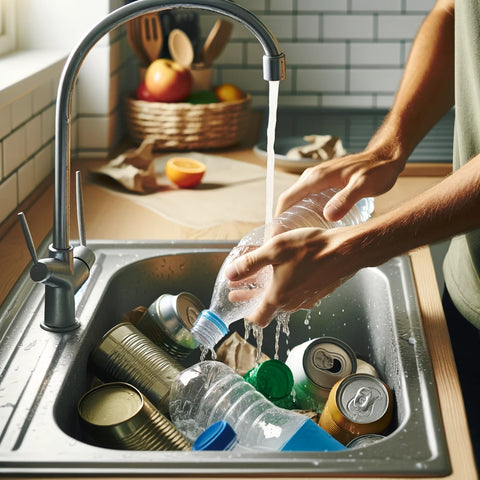
Rinse recyclables: Before putting recyclable materials in the bin, rinse them out to remove any food particles or residue. This can help to prevent contamination and improve the quality of the materials for recycling.
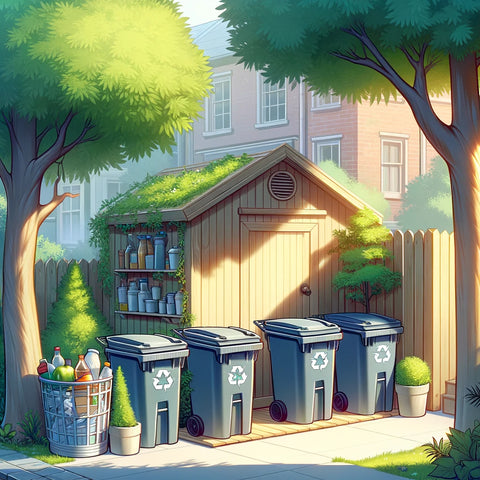
Store bins in a shaded area: If possible, store your trash and recycling bins in a shaded area to prevent them from overheating and emitting odors.
Use a bin deodorizer: To reduce odors, consider using a natural bin deodorizer such as baking soda, vinegar, or essential oils.
Don't overfill bags or bins: Overfilling bags or bins can cause them to break or spill, which can create a mess and attract pests.
Donate or sell unwanted items: Before throwing away unwanted items, consider donating or selling them to someone who may be able to use them. This can reduce waste and benefit someone else.

Compost food waste: Rather than throwing away food scraps, consider composting them instead. Composting is an easy and environmentally friendly way to turn food waste into nutrient-rich soil that can be used in your garden or for houseplants. You can purchase a compost bin or make your own using a container and some basic materials. By composting your food waste, you can reduce the amount of organic matter that goes into landfills and create a valuable resource for your plants.
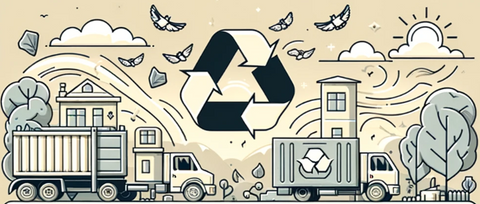
To store trash and recyclables in a way that is inaccessible to pests, here are some guidelines:
-
Use sealed containers: Place trash and recyclables in sturdy, lidded containers to prevent pests from accessing them. Make sure the containers have tight-fitting lids to keep odors and pests out.
-
Secure outdoor containers: If storing trash and recyclables outside, use animal-proof containers or secure them with bungee cords or heavy-duty straps to prevent animals from opening them.
-
Store in a clean area: Keep the storage area clean and free from spills or food debris that may attract pests. Regularly clean the containers and the surrounding area to minimize odors and the risk of infestations.
-
Avoid overfilling: Do not overfill the containers as it can make it easier for pests to access the contents. Leave enough space in the containers to properly close the lids.
When it comes to storing trash and recyclables in food service settings, the same principles apply. However, additional considerations include:
-
Separate containers: Use separate containers for trash and recyclables. Make sure they are clearly labeled to avoid confusion and encourage proper disposal.
-
Manage food waste: Dispose of food waste promptly and properly. Store it in leak-proof, tightly sealed containers to prevent attracting pests. Consider using designated food waste bins or composting systems if available.
-
Educate staff: Train and educate your staff about proper waste management practices, including how to store trash and recyclables correctly. Emphasize the importance of maintaining cleanliness to prevent pest problems.
When it comes to sorting recycling, follow these general guidelines:
-
Check local guidelines: Recycling guidelines can vary by location, so it's important to check with your local waste management authorities to understand which materials are accepted for recycling in your area.
-
Separate materials: Sort recyclables into different categories. Common categories include paper, cardboard, glass, plastic, and metal. Keep each material type separate to ensure they can be efficiently recycled.
-
Clean and remove contaminants: Rinse food and liquid residues from containers before recycling them. Remove any non-recyclable parts, such as metal lids or plastic caps, which may need separate disposal.
As for recycling dirty plastic, it depends on the specific type and level of dirt. Generally, plastic containers with light dirt or residue can be recycled after rinsing. However, heavily soiled or greasy plastic items may be considered contaminated and should be disposed of as regular trash. Check with your local recycling facility to determine their guidelines for recycling dirty plastic.
Related Articles
Best Practices for Storing Trash and Recyclables for Food Handlers
How to Properly Store Trash and Recyclables for Food Handlers
How Often Should You Take Out the Trash? Best Practices for Trash Disposal
How Trash Bags Can Help Combat Food Waste
Trash and Recyclables: A Guide to Proper Storage
How Do You Store Recycle Bins
How Do You Sort Your Recycling?
How should trash and recyclables be stored in a manner that limits pest access?
In a world where sustainable living is gaining prominence, managing household waste becomes pivotal. Discover the art of proper waste storage using cans and lids to keep pests at bay.
The Foundation: Choosing the Right Containers
Selecting the right cans and lids is the first step towards effective waste management. Opt for durable, tightly sealed containers to prevent pests from infiltrating your trash.
Trash Can 101: Size Matters
Size matters when it comes to trash cans. Choose a size that caters to your household's waste production, ensuring you don't overflow or underutilize the space. This simple step aids in maintaining cleanliness and hygiene.
The Lid Lockdown: Keeping Pests Out
A tightly secured lid acts as a fortress against unwelcome critters. Invest in cans with secure, animal-resistant lids to safeguard your waste from scavengers, maintaining a pest-free environment.
Recycling Revolution: Separate Bins for a Greener Tomorrow
Implement a dual-bin system for trash and recyclables. Not only does this promote eco-friendly practices, but it also makes the sorting process more manageable. Designate specific bins for each waste type to streamline recycling efforts.
Location Matters: Strategic Placement for Maximum Impact
Where you place your waste bins matters. Position them strategically, away from entrances and in well-lit areas. This minimizes the chances of pests being attracted to the garbage, ensuring a cleaner and more hygienic living space.
Regular Maintenance: The Key to a Pest-Free Zone
Regularly empty and clean your trash and recycling bins. Lingering odors and residues can attract pests. A routine maintenance schedule ensures a fresh and pest-resistant waste disposal system.
Going the Extra Mile: DIY Pest Deterrents
Enhance your waste management game with DIY pest deterrents. Consider sprinkling baking soda at the bottom of your bins or using natural repellents like peppermint oil. These simple additions can go a long way in keeping pests at bay.
Community Impact: Educating Others
Share your waste management expertise with your community. Educate neighbors on the importance of proper waste disposal and encourage the use of secure cans and lids. A collective effort can lead to a cleaner and pest-free neighborhood.
In conclusion, mastering the art of waste management involves thoughtful choices and strategic practices. By investing in the right containers, adhering to size considerations, securing lids, and implementing recycling measures, you can create a pest-resistant waste disposal system. Remember, regular maintenance and community education are crucial components in achieving a cleaner, greener living space.
Disclosure: This website, trashrite.com, participates in the Amazon Services LLC Associates Program, an affiliate advertising program designed to provide a means for sites to earn advertising fees by advertising and linking to Amazon.com. As an Amazon Associate, I earn from qualifying purchases. This means that when you click on certain links on this site and make a purchase, I may earn a commission at no additional cost to you. Your support through these purchases helps keep this website running. Thank you for your support!


